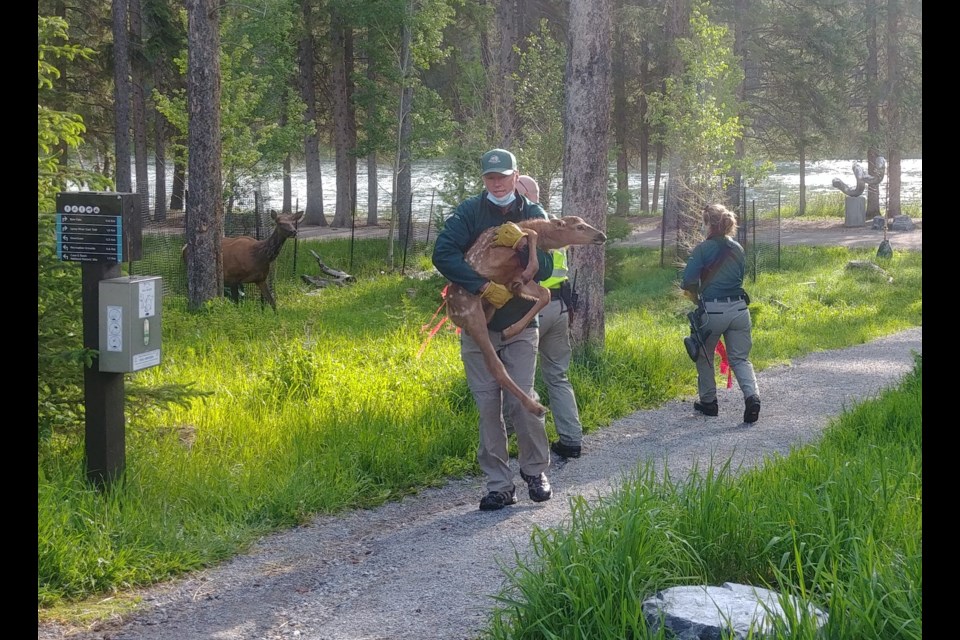BANFF – Spring elk calving season is about to get underway.
Parks Canada has issued its annual advisory for elk calving season, which typically occurs from about May 15 to June 30. Important calving grounds on a section of Tunnel Mountain have also been closed until the end of June.
Wildlife experts say elk should not be mistaken for tame animals just because they’re in town, on the golf course, trails or playing fields.
Dan Rafla, a human-wildlife coexistence specialist for Banff National Park, said cow elk can be aggressive when protecting their newborn calves by charging or striking with sharp hooves.
“Elk will be giving birth to their young and that’s a time they tend to have a heightened level of awareness and can display aggressive behaviour to people if they feel their calves are threatened,” he said.
“The best way to eliminate that is to give them space. We’re letting people know that if they see elk to give them a wide berth – of at least 30 metres.”
Elk typically use areas closer to the Banff townsite as a refuge to avoid predators during calving season.
Bears in Banff have been known to hunt elk calves and deer fawns on the outskirts of town, prompting wildlife experts to also remind residents and visitors many bears have emerged from their winter dens.
“Both elk calves and deer fawns are a sought-after prey source for bears,” said Rafla, noting bears are currently in the valley bottoms where there is more early season vegetation than in higher snow-filled elevations.
“There is a potentially higher chance of running into a bear in spring because of the smaller area of suitable habitat for bears to feed, and the increased seasonal prey source on which bears will be focusing on.”
Most elk are bred in September and into October, and after an approximately 245-day gestation period, cows will separate from the rest of the herd in spring to give birth.
A newborn calf can stand within 30 minutes to an hour of being born, but remains defenceless against predators for the first few weeks of its life. Because of this, cow elk keep the newborns well hidden in bushes and shrubs, but they always stand guard not too far away.
A cow elk will lick the calf to make sure it is perfectly clean and clear of any smells that could attract predators like wolves, bears or cougars. The lack of smell from licking and the spotted coat keep calves well camouflaged from predators, but wildlife experts say this also means that calves are difficult for people to see – often before it’s too late.
“As we start going into calving season and you see females alone, that’s something to really pay attention to and avoid,” said Rafla. “That elk may, in fact, have a calf hidden nearby, which often you will not see.”
The west slope of Tunnel Mountain, which is an important calving ground for elk due to low levels of human use, remains off limits to people until June 30 to give elk space and security.
All official trails in the surrounding area such as Tunnel Mountain Trail, Surprise Corner and the Bow River Trail remain open. Climbing access to the Black Band and Gonda Roof climbing is permitted via a different descent from Gonda Roof routes.
“This closure gives elk a place to potentially calve and not be disturbed,” said Rafla.
In the past, Parks Canada has also used the west slopes of Tunnel Mountain for relocation of elk calves when born in town, in backyards, or busy human-use areas.
Last year, there were at least eight occasions that elk had to be relocated, in what is referred to as a scoop-and-run.
“When calves are born in the open, there’s a risk to the public and a risk and stress to the elk,” said Rafla.
To avoid an elk encounter, Parks Canada advises people to stay at least 30 metres away from all elk, walk on roads rather than forested trails, keep children within arm’s reach and keep dogs on leash. They also recommend people travel in groups, make lots of noise, and carry a walking stick or umbrella.
If someone can't avoid an elk encounter, Parks Canada recommends acting dominant by raising your arms or flapping your jacket to make yourself appear bigger, seeking protection behind a tree or vehicle, maintaining eye contact and moving away.
“If an elk does make physical contact and you get knocked down – get up, get away. Do not play dead,’ said Rafla.
Bear spray is also recommended to thwart a potential elk attack.
“If you have an aggressive elk charging you, you can also deploy bear spray,” said Rafla. “We have observed that being effective in the elf.”
Parks Canada asks that all aggressive elk encounters be reported to Banff dispatch at 403-762-1470.
Earlier this month, Bow Valley WildSmart reported a female elk jumped across a six-foot fence and charged at people in Canmore, coming to a stop just short of making contact.
“Some of these female elk are already starting to have a need for more personal space and have low tolerance for humans approaching them,” stated the organization on its website.
“This serves as a good reminder that we all need to remember to give wildlife space and be aware of our surroundings, even on busy trails in town.”




